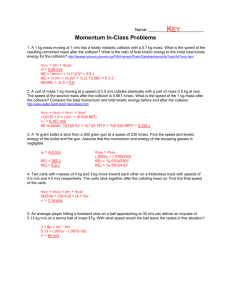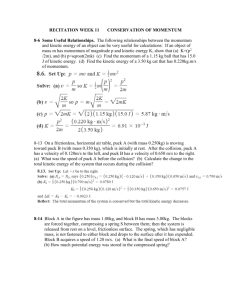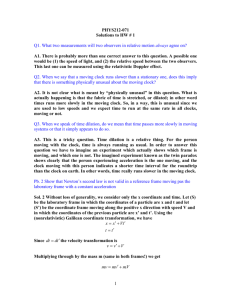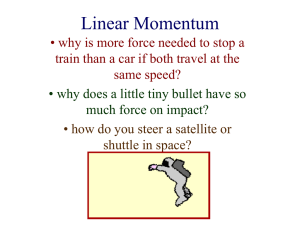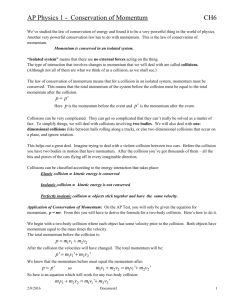Elastic Collision In 1D
advertisement
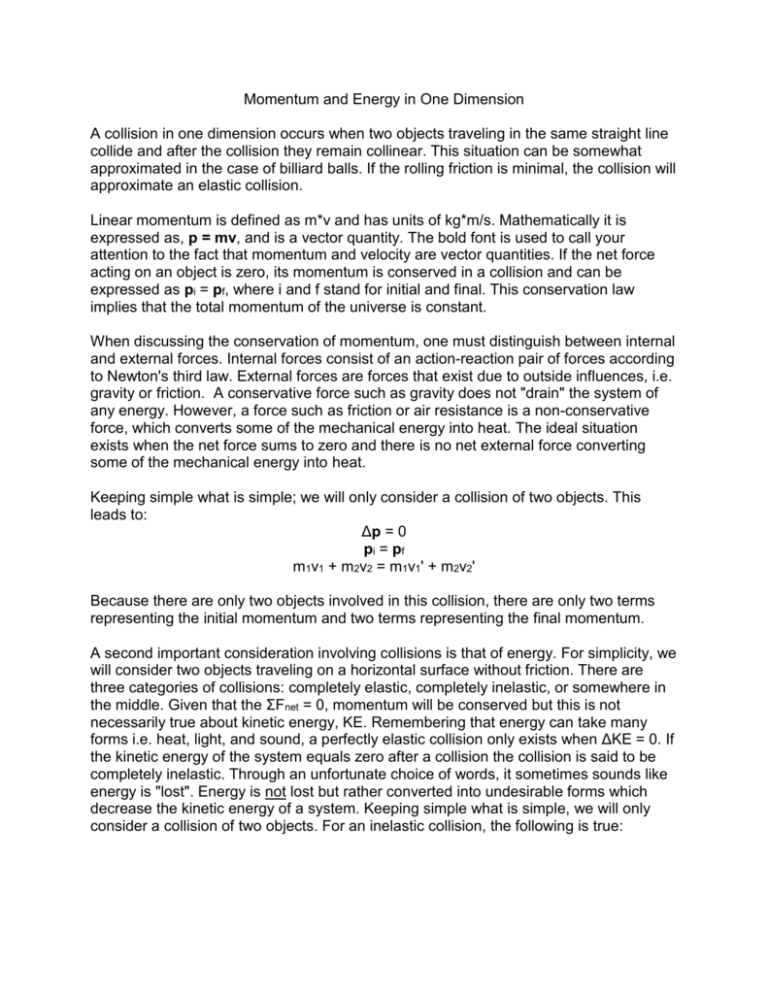
Momentum and Energy in One Dimension A collision in one dimension occurs when two objects traveling in the same straight line collide and after the collision they remain collinear. This situation can be somewhat approximated in the case of billiard balls. If the rolling friction is minimal, the collision will approximate an elastic collision. Linear momentum is defined as m*v and has units of kg*m/s. Mathematically it is expressed as, p = mv, and is a vector quantity. The bold font is used to call your attention to the fact that momentum and velocity are vector quantities. If the net force acting on an object is zero, its momentum is conserved in a collision and can be expressed as pi = pf, where i and f stand for initial and final. This conservation law implies that the total momentum of the universe is constant. When discussing the conservation of momentum, one must distinguish between internal and external forces. Internal forces consist of an action-reaction pair of forces according to Newton's third law. External forces are forces that exist due to outside influences, i.e. gravity or friction. A conservative force such as gravity does not "drain" the system of any energy. However, a force such as friction or air resistance is a non-conservative force, which converts some of the mechanical energy into heat. The ideal situation exists when the net force sums to zero and there is no net external force converting some of the mechanical energy into heat. Keeping simple what is simple; we will only consider a collision of two objects. This leads to: Δp = 0 pi = pf m1v1 + m2v2 = m1v1' + m2v2' Because there are only two objects involved in this collision, there are only two terms representing the initial momentum and two terms representing the final momentum. A second important consideration involving collisions is that of energy. For simplicity, we will consider two objects traveling on a horizontal surface without friction. There are three categories of collisions: completely elastic, completely inelastic, or somewhere in the middle. Given that the ΣFnet = 0, momentum will be conserved but this is not necessarily true about kinetic energy, KE. Remembering that energy can take many forms i.e. heat, light, and sound, a perfectly elastic collision only exists when ΔKE = 0. If the kinetic energy of the system equals zero after a collision the collision is said to be completely inelastic. Through an unfortunate choice of words, it sometimes sounds like energy is "lost". Energy is not lost but rather converted into undesirable forms which decrease the kinetic energy of a system. Keeping simple what is simple, we will only consider a collision of two objects. For an inelastic collision, the following is true: ΔKE ≠ 0 KEi ≠ KEf ½m1v12 + ½m2v22 ≠ ½m1v1'2 + ½m2v2'2 and for an elastic collision, the following is true ΔKE = 0 KEi = KEf 2 ½m1v1 + ½m2v22 = ½m1v1'2 + ½m2v2'2 Another must to remember is that energy is a scalar quantity. Unlike momentum which is a vector that you resolve vector components, energy is a scalar and a negative sign simply represents a decrease in energy. A collision in one dimension occurs when two objects traveling in the same straight line collide and after the collision they remain collinear. This situation can be somewhat approximated in the case of billiard balls. If the rolling friction is minimal, the collision will approximate an elastic collision. Momentum and Energy (Elastic Collisions) Problems 1) Two tennis balls each with a mass of 0.30 kg collide with each other. After the collision, the first ball moves to the right with a velocity of 4.0 m/s and the second ball moves to the left with a velocity of 5.0 m/s. (a) Given that the velocity of the first ball before the collision is 5.0 m/s to the left, determine the velocity of the second ball before the collision. m1 = 0.30 kg v1 = -5.0 m/s v1' = 4.0 m/s m2 = 0.30 kg v2 = ? v2' = -5.0 m/s Δp = 0 pi = p f m1v1 + m2v2 = m1v1' + m2v2' 0.30 kg*-5.0 m/s + 0.30 kg*v2 = 0.30 kg*4.0 m/s + 0.30 kg*-5.0 m/s v2 = 4.0 m/s to the right (b) Is the collision elastic? Justify your answer using calculations. ΔKE = 0 KEi = KEf ½m1v22 + ½m2v22 = ½m1v1'2 + ½m2v2'2 ½*0.30 kg*(-5.0 m/s)2+½*0.30 kg*(4.0 m/s)2 = ½*0.30 kg*(4.0 m/s)2+½*0.30 kg*(-5.0 m/s)2 6.2 J = 6.2 J Energy is conserved in this reaction making the collision elastic. You may be wondering why moving to the right is a positive velocity and to the left a negative velocity. There is no particular reason as long as you are consistent in your signs within the same problem. The same results would be obtained if you reversed the sign convention in the problem. In this case v2 = -4.0 m/s which would still mean the first mass before the collision would be moving to the right with a velocity of 4.0 m/s. Of course for the kinetic energy calculation it would not make any difference because the velocities are squared. 2) Two carts with masses of 2.0 kg and 0.90 kg are held together by a compressed spring. When released, the 2.0 kg cart moves to the left with a velocity of 6.0 m/s. (a) Determine the velocity of the 0.90 kg cart. m1 = 2.0 kg v1 = 0 m/s v1' = -6.0 m/s m2 = 0.90 kg v2 = 0 v2' = ? Δp = 0 pi = pf m1v1 + m2v2 = m1v1' + m2v2' 0 = 2.0 kg*-6.0 m/s + 0.90 kg*v2' v2' = 13 m/s to the right (b) Before the event (any change to the system can be thought of as an event), the two carts are stationary meaning that before the event the kinetic energy is zero. After the release, each cart is moving meaning that after the event the kinetic energy is non-zero. Is the conservation of energy being violated here? Justify your reasoning. The conservation of energy is not being violated. You must be careful how you define the system. In this problem, the system consists of two masses and a spring. The compressed spring possesses elastic potential energy that is converted into kinetic energy of the masses after the event. 3) A 4.0 kg mass is moving with a velocity of 12 m/s and collides with a stationary mass of 2.0 kg. Calculate the velocity of each mass after the collision. m1 = 4.0 kg v1 = 12 m/s v1' = ? m2 = 2.0 kg v2 = 0 v2' = ? Δp = 0 pi = p f m1v1 + m2v2 = m1v1' + m2v2' 4.0 kg*12 m/s + 0 = 4.0 kg*v1' + 2.0 kg*v2' 24 m/s = 2.0*v1' + v2' (1) Not a pretty sight! This is an example of one equation with two unknowns. However, life is good because we are told that this is an elastic collision which means that the conservation of kinetic energy is valid. ΔKE = 0 KEi = KEf ½m1v2 + ½m2v22 = ½m1v1'2 + ½m2v2'2 ½*4.0 kg *(12 m/s)2 + 0 = ½*4.0 kg*v1'2 + ½*2.0 kg*v2'2 288 m2/s2 = 2.0*v1'2 + v2'2 (2) The problem becomes doable because equations (1) and (2) represent simultaneous equations. If we solve (1) for v2' and substitute into (2), we will be left with one equation with one unknown. It is important to note that you will need to solve a quadratic equation and the answers should be v1' = 4.0 m/s and v2' = 16 m/s
